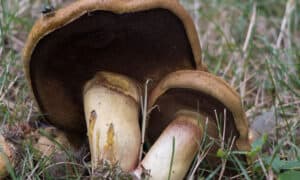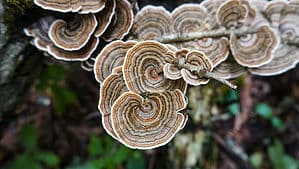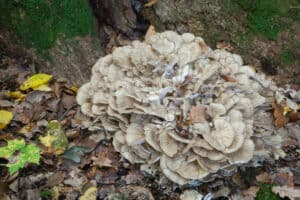Looking for mushrooms that can serve as a chicken alternative? There are a few wild and cultivated mushroom species that resemble the taste and texture of chicken, depending on the preparation and cooking methods.
In this guide, we’ll delve into three species of mushrooms that taste like chicken. Remember, if you’re going to forage for wild edible mushrooms, only consume what you can identify with 100% certainty. If you aren’t experienced in identifying edible mushrooms in your region, it’s best to attend forays with a mycology group or seek out a mushroom expert.
Read on to learn more.
Mushrooms That Taste Like Chicken: Chicken of the Woods (Laetiporus sulphureus)
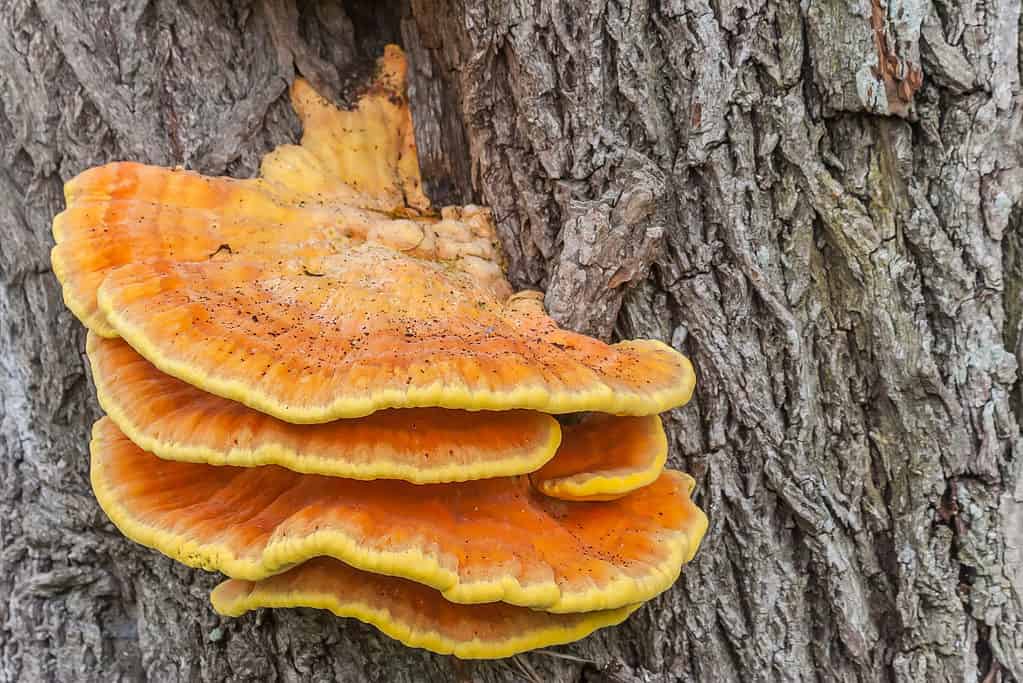
The sulfur shelf is another name for
Laetiporus sulphureus.
©Marc Venema/Shutterstock.com
As its common name suggests, chicken of the woods (Laetiporus sulphureus) is a bracket mushroom native to Europe and North America with a texture and taste similar to chicken. Technically, chicken of the woods is the common name for several choice, edible species of bracket mushrooms in the Laetiporus genus. The most well-known species, however, is L. sulphureus.
Widespread in North America’s eastern hardwood forests, Laetiporus sulphureus exhibits parasitic and saprobic behaviors on living and dead hardwoods, primarily oaks. Specifically, this species of chicken of the woods prefers to grow on weakened or dead oak trees. You will primarily find them fruiting in the late summer and fall, but you’ll sometimes find them in the spring.
These striking mushrooms feature fan-shaped caps with an undulating margin. They tend to grow in tight clusters that can create rosette shapes. When young, L. sulphureus is bright orange-yellow and spongy. As it ages, the color fades to a dull light orange-white and becomes much more firm. They are not pleasant to eat at this stage. The pore surface of this bracket species is bright to dull yellow, depending on its life stage.
As with all mushrooms, make sure to thoroughly cook chicken of the woods before consuming. The Laetiporus genus, in particular, is known to cause GI upset when eaten undercooked. Cook them for at least 15 minutes to greatly reduce the risk of stomach upset. Most people enjoy pan-frying chicken of the woods with butter, garlic, and shallots. You can also bread and fry these mushrooms to create vegan “fried chicken” sandwiches and other meat alternative dishes.
King Trumpet (Pleurotus eryngii)
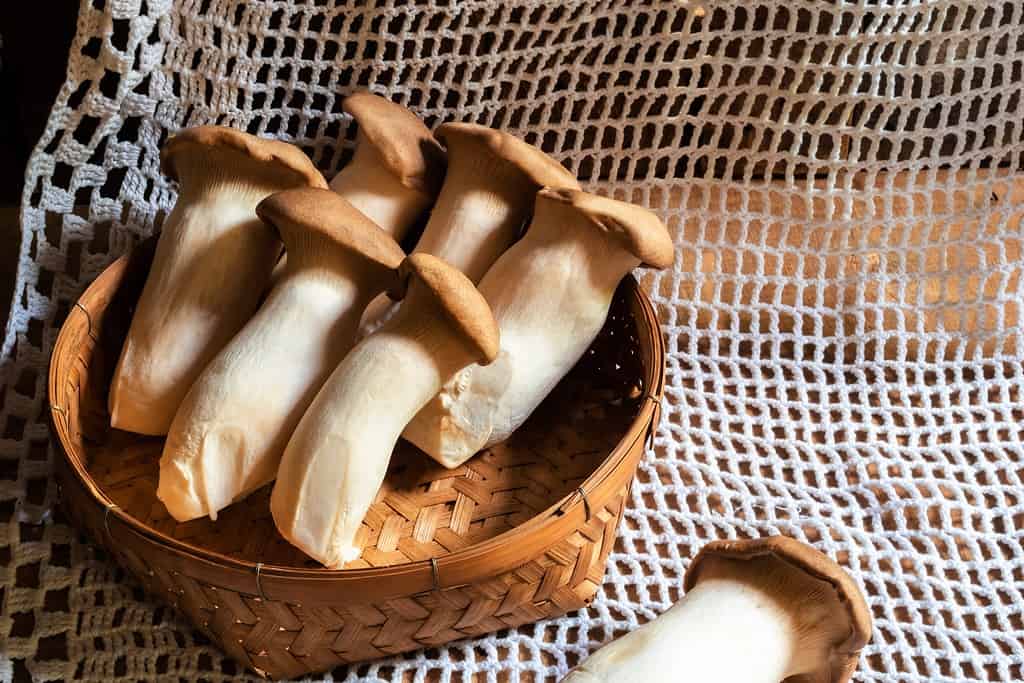
King oysters are meaty mushrooms that can normally be found cheap at your local Asian grocery.
©nnk/Shutterstock.com
The king trumpet, or king oyster mushroom (Pleurotus eryngii), is a delicious and widely cultivated mushroom that delivers a delightful taste and texture similar to chicken. This meaty mushroom has a lovely, mild flavor and can taste remarkably like chicken when poultry spices are added.
This species of oyster mushroom looks quite different from other species in the Pleurotus genus. While most oysters feature rudimentary stipes (stem), the stipe of king oysters is fully developed and prominent. They can measure up to 8 inches long and about 3 inches thick. The caps are usually brown to grey, convex to funnel-shaped, and feature decurrent pale brown-pale tan gills.
These mushrooms are native to temperate, humid regions of the Mediterranean, Asia, and North Africa. They are also widely cultivated, typically in supplemented, sterile hardwood sawdust. In nature, they prefer to grow on the roots of hardwood trees.
The thick flesh of this species makes it an excellent meat alternative. Popular recipes for king trumpet mushrooms include breading and frying, sauteing, grilling, and glazing and baking. Some popular dishes to feature Pleurotus eryngii include rice and vegetable stir-fries, east Asian noodle dishes, creamy soups, baked vegan “chicken” dishes, pesto and alfredo pasta, and grilled “chicken” or “scallop” dishes.
Mushrooms That Taste Like Chicken: Aborted Entoloma (Entoloma abortivum)
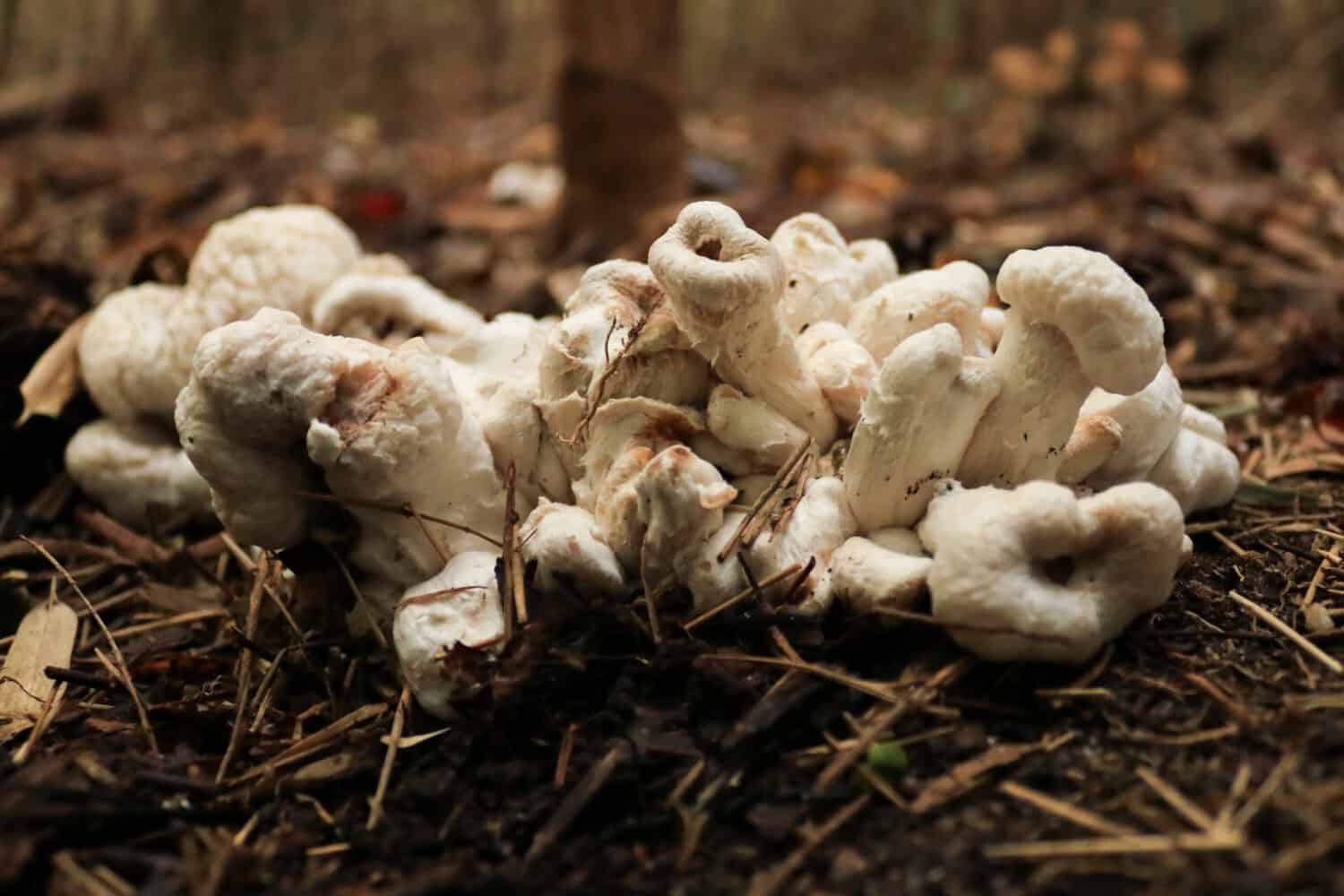
Shrimp of the woods can be quite common in places where you find honey mushrooms.
©Anya Douglas/Shutterstock.com
The aborted entoloma (Entoloma abortivum) is an interesting fungus with a common name that is likely a misnomer. For decades, researchers believed that honey mushrooms parasitize Entoloma abortivum, causing their aborted form. Mycologists call this lumpy, aborted form carpophoroid. However, a recent study indicates that the inverse is true. Instead, honey mushrooms in the Armillaria genus are being parasitized by Entoloma abortivum.
The white carpophoroids, which resemble shrimp, typically appear at the base of stumps in late summer and fall. They are sometimes accompanied by normal fruiting bodies of both honey mushrooms and E. abortivum. These mushrooms are quite enjoyable to harvest, and you can often find more by digging a couple of inches into the soil around the stump. Amanita eggs can look somewhat similar to the untrained eye, so make sure you know the difference before picking. Most people choose to not harvest E. abortivum as a normally fruiting cap-and-stipe mushroom as there are several poisonous lookalikes in the Entoloma genus.
While another common name for this mushroom is shrimp of the woods, many folks also find that this mushroom resembles the taste and texture of chicken, when cooked properly. Make sure to cook this mushroom for at least 15 minutes and allow it to brown, which brings out a lovely meaty flavor. These mushrooms are fantastic breaded and fried, as well as glazed and baked. You can use them in several vegan “chicken” dishes such as “fried chicken” sandwiches, baked “chicken”, and creamy “chicken” alfredo pasta.
The photo featured at the top of this post is © alisafarov/Shutterstock.com
The information presented on or through the Website is made available solely for general informational purposes. We do not warrant the accuracy, completeness, or usefulness of this information. Any reliance you place on such information is strictly at your own risk. We disclaim all liability and responsibility arising from any reliance placed on such materials by you or any other visitor to the Website, or by anyone who may be informed of any of its contents. None of the statements or claims on the Website should be taken as medical advice, health advice, or as confirmation that a plant, fungus, or other item is safe for consumption or will provide any health benefits. Anyone considering the health benefits of particular plant, fungus, or other item should first consult with a doctor or other medical professional. The statements made within this Website have not been evaluated by the Food and Drug Administration. These statements are not intended to diagnose, treat, cure or prevent any disease.
Thank you for reading! Have some feedback for us? Contact the AZ Animals editorial team.




